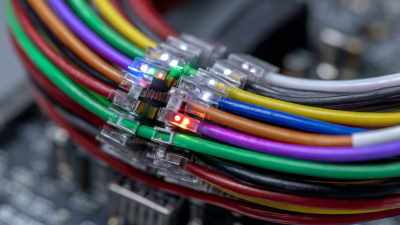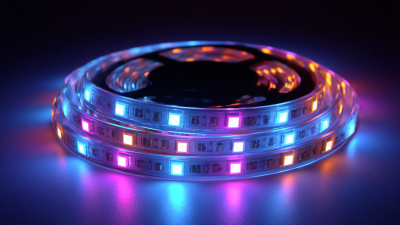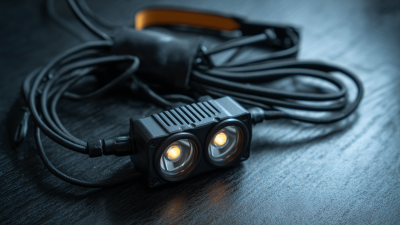How to Choose the Right LED Light Wiring Harness for Your Projects
In the ever-evolving world of automotive and industrial lighting, selecting the appropriate LED light wiring harness has become crucial to ensure optimal performance and longevity. According to industry reports, the global LED lighting market is projected to reach $160 billion by 2026, with a significant portion driven by the adoption of energy-efficient lighting solutions. The right LED light wiring harness not only enhances the functionality of your lighting systems but also contributes to improved safety and reliability. With a myriad of options available, it's essential to consider factors such as voltage rating, wire gauge, and environmental resistance when making a selection. This blog aims to guide you through the intricacies of choosing the right LED light wiring harness for your projects, ensuring that you meet both performance standards and project requirements efficiently.

Understanding the Basics: What is an LED Light Wiring Harness?
An LED light wiring harness is a crucial component for successfully integrating LED lighting into various projects, from automotive to home installation. Essentially, it serves as a connector system that streamlines the electrical connections between LED lights and power sources, ensuring efficient operation while minimizing the risk of electrical failures. According to a recent industry report by MarketsandMarkets, the global market for LED lighting is expected to grow from $76 billion in 2020 to over $106 billion by 2025, highlighting the increasing reliance on efficient lighting solutions and the importance of robust wiring harness systems.
Understanding the specifics of LED light wiring harnesses is vital for any project involving LED technology. These harnesses come in various configurations, tailored to specific needs such as voltage requirements and circuit design. A study conducted by the Lighting Research Center revealed that properly designed wiring harnesses can enhance the performance and lifespan of LED fixtures by nearly 30%. Therefore, selecting the appropriate harness based on wire gauge, insulation type, and connector compatibility is essential in ensuring optimal functionality and safety in your lighting projects.
Key Factors to Consider When Selecting an LED Light Wiring Harness
When selecting an LED light wiring harness for your project, several key factors must be considered to ensure optimal performance and safety. First and foremost, the voltage rating of the harness should match the LED lights. Research indicates that mismatched voltage can lead to a significant reduction in lifespan—up to 50% shorter—due to overheating and overcurrent issues. For instance, a 2019 report by the Lighting Research Center highlights that proper voltage alignment can enhance the efficiency of LED systems by up to 20%.
Another crucial aspect is the gauge of the wiring. Thicker wires may be necessary for higher wattage lights, as demonstrated by a study from the American National Standards Institute (ANSI), which states that using inadequate wire gauge could cause detrimental voltage drops, affecting brightness and color temperature. Moreover, considering environmental conditions is essential; for projects exposed to moisture, selecting water-resistant harnesses can prevent corrosion and electrical failures, thus gracing the longevity of the installation. These key factors collectively ensure that your LED lighting project operates efficiently and reliably, aligning with industry best practices.

Different Types of LED Light Wiring Harnesses and Their Applications
When it comes to selecting the appropriate LED light wiring harness for your projects, understanding the different types available is crucial. LED wiring harnesses serve as the backbone of your lighting setup, connecting the lights to the power source efficiently. From basic setups to complex lighting systems requiring multiple connections, various types of harnesses cater to different applications. For instance, some harnesses are designed for simple plug-and-play installations for smaller LED lights, while others are built to handle larger arrays or specialized lighting configurations.
Several factors influence the choice of a wiring harness, including the type of LED lights used and the environment in which they will be installed. Outdoor installations may require waterproof or rugged wiring harnesses, while indoor setups might prioritize minimal aesthetics. Additionally, trends in renewable energy and sustainability are shaping the market, with manufacturers increasingly offering eco-friendly materials and designs. Understanding these options empowers you to make informed decisions, ensuring your projects not only meet technical requirements but also align with a growing focus on sustainable practices.
Tips for Ensuring Compatibility with Your LED Lighting Projects
When it comes to selecting an LED light wiring harness for your projects, ensuring compatibility is paramount. Start by identifying the voltage requirements of your LED lights. Common voltages include 12V and 24V, so make sure that the wiring harness you choose matches these specifications. Mismatched voltages can lead to inefficiency, flickering, or even damage to your LED fixtures. It's also essential to check the amperage rating; the harness should be able to handle the total current draw of all connected LEDs without overheating.
Another key factor is connector compatibility. Different LED lights may come with various connector types, such as Molex or JST connectors. Before making a purchase, verify that the harness connectors align with those of your LED lights for a seamless installation. Additionally, consider the length of the wiring harness, especially for larger projects. Having enough length can prevent strain on the wires and allow for a cleaner setup. Overall, taking these compatibility factors into account will significantly enhance the performance and longevity of your LED lighting projects.
Common Mistakes to Avoid When Choosing a Wiring Harness for LEDs
When selecting a wiring harness for LED projects, it's crucial to avoid common pitfalls that can lead to inefficiencies or even failures in your lighting setup. One prevalent mistake is underestimating the current requirements of your LED lights. According to a report by the Illuminating Engineering Society (IES), using a harness that can't handle the required amperage can cause overheating, which may damage both the harness and the LEDs. Always calculate the total wattage of your LED setup and choose a harness that exceeds this capacity to ensure safety and longevity.

Another frequent error is choosing a wiring harness based solely on price without considering quality. High-quality materials significantly affect performance and durability. A study by the National Electrical Manufacturers Association (NEMA) indicates that investing in premium components can reduce failure rates by up to 30%. It's advisable to opt for harnesses made from robust, heat-resistant materials that comply with relevant industry standards.
Tip: To ensure a hassle-free installation, always check compatibility with your LED's voltage and current specifications before purchasing a wiring harness. Additionally, consider buying from reputable manufacturers who provide detailed product information to help make informed decisions.
Related Posts
-

Unlocking the Technical Specifications of the Best LED Light Wiring Harness for Global Buyers
-

The Ultimate Guide to Choosing the Perfect LED Strip for Your Project
-

Top Strategies for Sourcing Innovative Wire Lights in the Global Market
-

Top Strategies for Enhancing Performance with LED Connectors
-

How to Choose the Best LED Light Harness for Optimal Performance and Efficiency
-

Exploring Unique Alternatives to Traditional LED Wiring Harness Solutions
